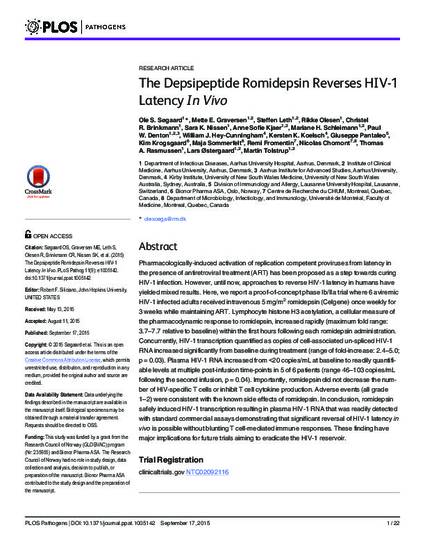
Pharmacologically-induced activation of replication competent proviruses from latency in the presence of antiretroviral treatment (ART) has been proposed as a step towards curing HIV-1 infection. However, until now, approaches to reverse HIV-1 latency in humans have yielded mixed results. Here, we report a proof-of-concept phase Ib/IIa trial where 6 aviremic HIV-1 infected adults received intravenous 5 mg/m2 romidepsin (Celgene) once weekly for 3 weeks while maintaining ART. Lymphocyte histone H3 acetylation, a cellular measure of the pharmacodynamic response to romidepsin, increased rapidly (maximum fold range: 3.7–7.7 relative to baseline) within the first hours following each romidepsin administration. Concurrently, HIV-1 transcription quantified as copies of cell-associated un-spliced HIV-1 RNA increased significantly from baseline during treatment (range of fold-increase: 2.4–5.0; p = 0.03). Plasma HIV-1 RNA increased from <20 copies/mL at baseline to readily quantifiable levels at multiple post-infusion time-points in 5 of 6 patients (range 46–103 copies/mL following the second infusion, p = 0.04). Importantly, romidepsin did not decrease the number of HIV-specific T cells or inhibit T cell cytokine production. Adverse events (all grade 1–2) were consistent with the known side effects of romidepsin. In conclusion, romidepsin safely induced HIV-1 transcription resulting in plasma HIV-1 RNA that was readily detected with standard commercial assays demonstrating that significant reversal of HIV-1 latency in vivo is possible without blunting T cell-mediated immune responses. These finding have major implications for future trials aiming to eradicate the HIV-1 reservoir.

© 2015 Søgaard et al. This is an open access article distributed under the terms of the Creative Commons Attribution License, which permits unrestricted use, distribution, and reproduction in any medium, provided the original author and source are credited.